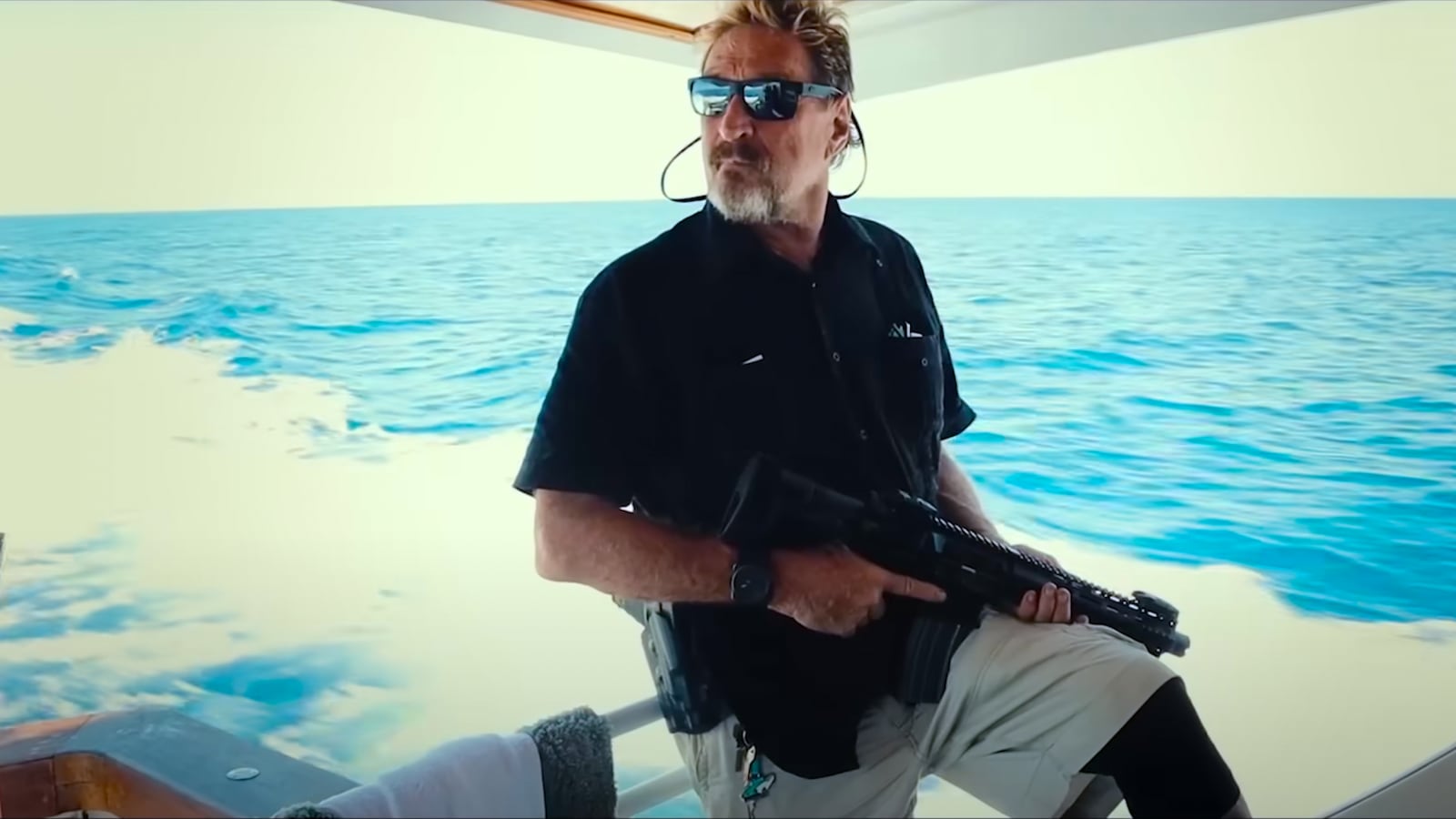John McAfee became unbelievably wealthy by protecting others’ computers, and yet at a certain point in his life, the notorious antivirus software pioneer decided that the only means of protecting himself was to move overseas, arm himself to the teeth, ingest tons of drugs and booze, and routinely flee from law enforcement and shadowy forces that he saw lurking around every corner. Charlie Russell’s Netflix documentary Running with the Devil: The Wild World of John McAfee is culled from footage of McAfee during the last decade of his life, when he hop-scotched between tropical islands, Miami, and Central America. What it boasts in up-close-and-personal chaos, however, it lacks in revealing coherence.
Following the type of brief table-setting montage that has become de rigueur on Netflix and its streaming brethren, Running with the Devil (Aug. 24) picks up with reporter Rocco Castoro and cameraman Robert King in December 2012. On assignment for Vice, the duo board a plane for Belize to join up with McAfee, a millionaire who’s been living in the Central American country for years, and is presently accompanied by his girlfriend Sam. McAfee is, at this juncture, in hiding from Belizean authorities who he thinks are going to kill him because they blame him for the death of his neighbor, 52-year-old Florida native Gregory Faull, who was shot once in the back of the head mere days after the two had sparred over McAfee’s dogs and their intimidating conduct toward Faull’s beloved parrot. Local reporter Jose Sanchez states outright that there’s “a high probability” that McAfee had something to do with Faull’s execution-style murder, and when Castoro and King meet McAfee, he claims that he's wanted by Belize’s prime minister, who has placed a $150,000 dead-or-alive bounty on his head.
To add to this scene’s craziness, once ushered into an airport SUV, Castoro and King are greeted by a weathered, goateed McAfee munching on rose petals and rehearsing a, let’s say, politically incorrect disabled-man routine that he thinks will help him evade detection.
From the moment McAfee appears on screen, it’s clear that he’s a maniac, and the remainder of Russell’s film serves to repeatedly reconfirm that first impression. Running with the Devil thrusts one into its heady on-the-lam scenario, dispensing only tidbits of backstory along the way. That lends the material a bit of early energy, aided by the sheer strangeness of McAfee, who brags about hacking the Belizean government’s cellphones, frets about being arrested at any second, and swiftly spirits everyone away to Guatemala by boat—a decision that leads to more trouble when, upon arrival, they’re questioned at length about not having proper passport stamps (from exiting Belize), and are forced to enlist the aid of Sam’s great-uncle, who just so happens to be the country’s former attorney general.
As Castoro and King recall, this was breakneck weirdness on a nerve-wracking scale, and Running with the Devil ably conveys the aura of danger and excitement that McAfee created wherever he went. King’s clips of McAfee trying to negotiate his way out of customs trouble, hiring Sam’s relative as his legal representative, musing about his Joker-like persona (“Do you think I give a shit? No, people, I do not”) and proclaiming that he can access anyone and everyone’s data are legitimately off-the-wall, and paint him as an unhinged psychopath driven by deeply rooted paranoia. Of course, some of those fears are warranted, since at certain stops along his ramshackle journey, strangers do seem to be pursuing him. Nonetheless, the portrait that emerges is of an individual lost in a fugue generated by equal parts persecution-complex neuroses, I’m-the-center-of-the-world narcissism, and narcotized delusions.
McAfee comes across as a smart, self-centered rich guy with a brain addled by far too many illicit substances (including, as one person suggests, copious bath salts), and Running with the Devil charts his brief but eventful odyssey with Castoro and King—whose presence was intended to feed his ego and protect him from public arrest—and, in 2019, with just King, who rejoined him on a boat that soon made its way to the Dominican Republic. By that time, McAfee had already run for president in the 2016 U.S. election as a Libertarian Party candidate. He had also, while in Miami following his stint in Guatemala, married Janice, a prostitute who admits that she hitched her wagon to McAfee because she “just saw an opportunity.” It’s a love story that fits perfectly into this bizarre saga, which races headlong into greater madness as McAfee searches his sea-faring vessel for clandestine stowaways and chugs bottles of liquor for breakfast, and Janice recounts how her pimp conspired with members of Mexico’s Sinaloa cartel to force her to try to poison her new husband.
McAfee’s out-of-control behavior is mildly entertaining in a car crash sort of manner, but mostly, he proves an exhausting, one-note loose cannon. Grinning devilishly and constantly alerting everyone to impending mortal threats that must be immediately fled, he’s a wacko who becomes less believable as Running with the Devil goes on. King and ghostwriter Alex Cody Foster both speak fondly of him, this despite their comments about his dangerousness—and, also, about the possibility that he killed Faull as well as, decades earlier, his father (whose death was deemed a suicide). Yet with only scraps of verifiable facts and news reports to go on here, there’s no telling what’s real and what’s fiction, and while director Russell’s refusal to contextualize the action is initially rousing, it eventually undermines any attempt to understand McAfee and the brazen choices he made.
McAfee committed suicide on June 23, 2021, in a Barcelona prison, where he was awaiting extradition to the United States on tax evasion charges that could have netted him 30 years behind bars. Given his incessant contentions that he was in dire peril, many continue to believe—in Jeffrey Epstein-style conspiratorial fashion—that he fell victim to nefarious forces. Running with the Devil, however, has no concrete answers about the late mogul, only lots of fly-on-the-wall derangement that obscures, rather than illuminates, the truth.







